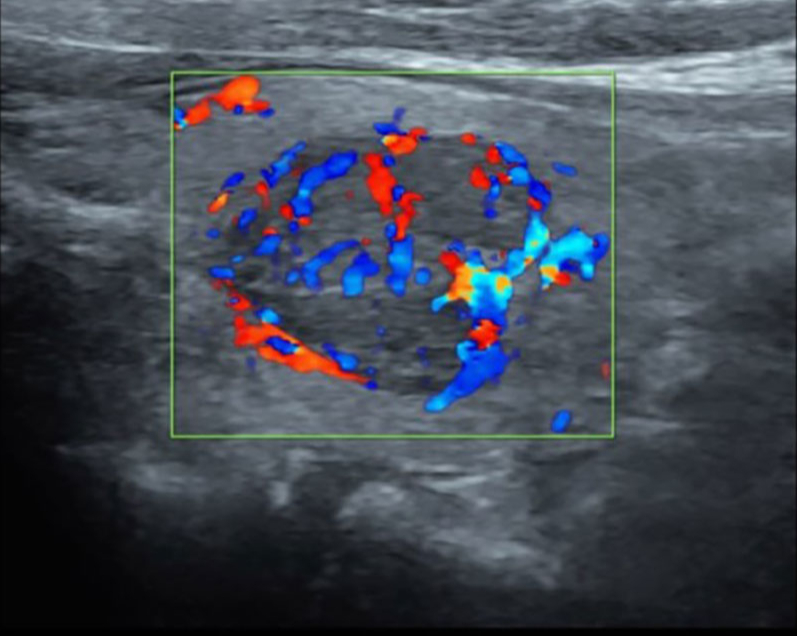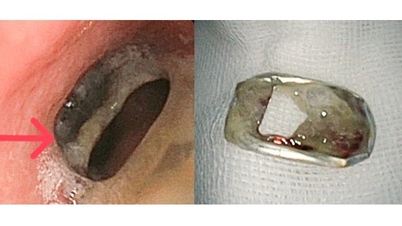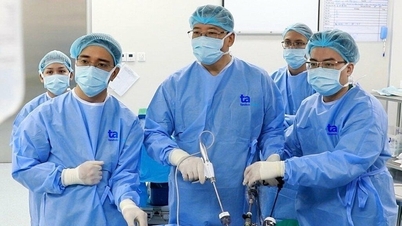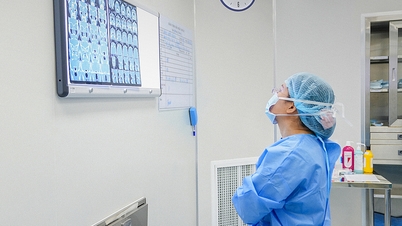GĐXH - At the hospital, the patient was diagnosed with medullary thyroid cancer. This is a rare disease, accounting for about 1-2% of all thyroid cancers.
Recently, Medlatec Clinic No. 01 received Mr. BVĐ (53 years old, in Hai Duong ) for examination due to frequent dry cough and difficulty swallowing.
Here, Mr. D. was examined and performed paraclinical tests. Notably, the thyroid ultrasound showed a highly suspicious thyroid nodule, classified as TIRADS 4. The patient then underwent fine needle aspiration (FNA) of the thyroid nodule under ultrasound guidance.

Thyroid ultrasound showed a thyroid nodule with high suspicion of malignancy, TIRADS classification 4.
Based on the cytological image, the specialists pointed to medullary thyroid carcinoma. The patient then underwent total thyroidectomy.
The histopathological and immunohistochemical results were completely consistent with pT1b stage medullary thyroid carcinoma. This is an early stage, with a very good prognosis for the patient.
Currently, the patient's condition is stable, receiving hormone replacement therapy with Levothyroxine and scheduled for regular follow-up.
What is medullary thyroid carcinoma?
According to MSc. Dr. Nguyen Thi Hong Nga - Pathology Center, Medlatec Healthcare System, medullary thyroid carcinoma (MTC) is a neuroendocrine tumor originating from C cells (parafollicular cells) of the thyroid gland, originating from the terminal branch of the neural crest and capable of secreting calcitonin.
The disease is also known as C-cell carcinoma, amyloid stromal solid carcinoma, or perifollicular cell carcinoma.
MTC is a rare disease, accounting for about 1-2% of all thyroid cancers. The disease can appear in 2 forms: individual form: Accounting for about 70%, often found in people aged 40-60, manifesting as a solitary mass in the thyroid gland.
Hereditary form: Accounts for about 30%, usually appearing in younger patients (average age 35). This form is associated with genetic syndromes such as MEN 2A, MEN 2B, familial medullary thyroid cancer syndrome, von Hippel-Lindau disease or neurofibromatosis.
The main cause is a germline mutation in the RET gene, which can be detected by serum calcitonin screening or RET gene mutation analysis in peripheral blood.
Symptoms of the disease also differ between stages and progression. Accordingly, the disease often begins with the appearance of a painless thyroid tumor, cold nodule on Doppler.
Approximately 75% of patients have lymph node metastases, mainly involving the mediastinum, ipsilateral and contralateral jugular chain, while 10% have distant metastases. In addition, serum calcitonin levels correlate closely with tumor size.
If the disease has metastasized, the patient may experience severe diarrhea and facial flushing.
Russian doctors warn that medullary thyroid carcinoma is a rare form of thyroid cancer with a high level of malignancy. If not detected promptly, the disease can metastasize to the lymph nodes and distant organs, seriously affecting the patient's health and life.
Therefore, early screening plays an important role in minimizing the risk of progression and improving treatment prognosis.
Source: https://giadinh.suckhoedoisong.vn/thuong-xuyen-ho-khan-nuot-nghen-nguoi-dan-ong-53-tuoi-duoc-phat-hien-ung-thu-172250207083050582.htm






![[Photo] Worshiping the Tuyet Son statue - a nearly 400-year-old treasure at Keo Pagoda](/_next/image?url=https%3A%2F%2Fvphoto.vietnam.vn%2Fthumb%2F1200x675%2Fvietnam%2Fresource%2FIMAGE%2F2025%2F12%2F02%2F1764679323086_ndo_br_tempimageomw0hi-4884-jpg.webp&w=3840&q=75)
![[Photo] Parade to celebrate the 50th anniversary of Laos' National Day](/_next/image?url=https%3A%2F%2Fvphoto.vietnam.vn%2Fthumb%2F1200x675%2Fvietnam%2Fresource%2FIMAGE%2F2025%2F12%2F02%2F1764691918289_ndo_br_0-jpg.webp&w=3840&q=75)






































































































Comment (0)